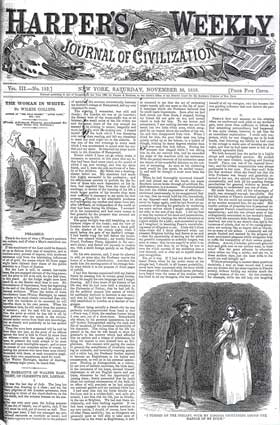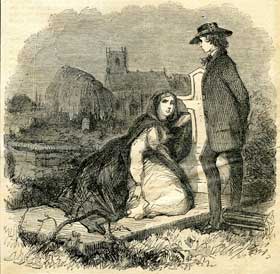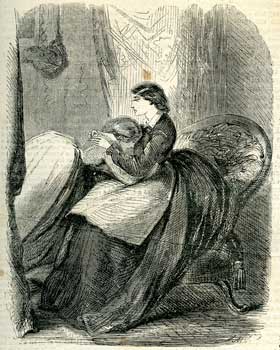
The Woman in White, White Space
and Mid-Victorian Print Technology
- Mary E. Leighton - Lisa Surridge
_______________________________

Fig. 2. En-tête de chapitre, Harper’s Weekly, 1859 

Fig. 3. J. McLenan, « The hand holding
the damp cloth... », 1859 

Fig. 4. J. McLenan, « And rested her head... », 1860,
Fig. 5. J. McLenan, « And pinned it carefully... », 1860,
Fig. 6. J. McLenan, En-tête de chapitre, 1860,
Fig. 7. J. McLenan, « Just as my hand was on the door... », 1860,
Fig. 8. J. McLenan, « “Hush!” she whispered... », 1860,
Fig. 9. J. McLenan, « Mr. Fairlie declared... », 1860 
Part 1’s opening page layout in Harper’s reinforces this association of the unnamed woman with a blank page to be read, as the chapter head at the upper left-hand corner (fig. 2) features a largely blank page held up by the excited Professor Pesca. In the text, this is the letter that gets Hartright his job as drawing master at Limmeridge. However, on the printed page of Harper’s Weekly, the letter appears largely as white space. Like the woman in white, it appears first a blank to be filled in, a text to be read. The association of the woman in white with visual white space continues throughout the forty weeks of the Harper’s serial: even after she is named as Anne Catherick and given a back story, the woman in white is consistently associated with the blank, un-inked portion of the engravings.
The most significant of these is Part 6’s image of Hartright encountering Anne crouched upon Mrs. Fairlie’s white gravestone and cleaning its textual inscription (fig. 3). As in the illustration to Part 1, this image is dominated by contrasts. At Mrs. Todd’s suggestion, Anne wears a dark cloak to conceal her white clothing, a textual detail that the artist deploys as a means of highlighting the white space of her dress, which in turn comprises the illustration’s focal point. Hartright, again portrayed in dark clothing, stands to the right of the gravestone, which stands out in relief against his dark clothing and Anne’s dark cloak. The visual effect associates Anne with the grave that she is cleaning and predicts her early death. Significantly, the illustration also repeats Part 1’s association of the woman in white with text, as the caption indicates she is engaged in “cleaning the inscription” of Mrs Fairlie’s grave marker. [16] She is thus performing a task that parallels that of the serial’s engravers: she is preoccupied with meaning that is created by hollowed spaces, by what is not there.
As in Part 1, where her dialogue is marked by the repeated form of the question, in Part 6, Anne is once again characterized by a bizarrely repeated speech pattern. In this case, it takes the form of homiologia—that is, the repetition of a word to the point of redundancy. Her dialogue with Hartright is dominated by the single word, white. The repetition of this word first reinforces meaning, but as it approaches saturation, meaning is evacuated:
Ah! she was fond of white in her lifetime; and here is white stone about her grave – and I am making it whiter for her sake. She often wore white herself; and she always dressed her little daughter in white. Is Miss Fairlie well and happy? Does she wear white now as she used when she was a girl? [17]
In verbal and in visual text, then, the woman in white is linked to repetition: the repeated image of white space, the repeated question, and the repeated word white. In each instance, such repetition is itself associated with the negative or the empty: the evacuated or un-inked part of the image, the question rather than the answer, the word from which meaning is evacuated.
As we have noted, the novel’s plot revolves first around the identification of Laura with the woman in white and then around Hartright and Marian’s attempts to distinguish between the two and thereby to reestablish Laura’s unique identity. In the verbal text, the identification between Anne and Laura starts when Marion reads to Hartright a letter from Mrs. Fairlie to her husband describing Anne Catherick’s childhood arrival in the village. Mrs. Fairlie’s letter reveals how she gave to Anne Laura’s castoff white clothes and how Anne promised gratefully to “always wear white.” [18] As Marian reads this passage, Hartright sees Laura passing on the terrace: “There stood Miss Fairlie, a white figure, alone in the moonlight (...) the living image (...) of the woman in white!” [19] Just as the clothes pass from Laura to Anne, so too does the identification of the woman in white pass from Laura (as girl in white) to Anne (as girl, then woman in white), then back to Laura (as woman in white).
Visually, the Harper’s Weekly serial underscores this identification by transferring the association of white space from Anne, the initial woman in white, to Laura, her visual double. The illustrations consistently depict Laura as a white figure, either in relief against a background or contrasted with her half-sister Marian’s dark form. The pairing of the two sisters establishes a striking visual pattern of repeated pairings: a woman in white with a woman in black (figs. 4-9). This association of Laura with hollowness and blankness symbolizes her legal status under marital coverture and prepares readers for the moment at which her identify is finally stolen by Count Fosco and Sir Percival Glyde. In this scheme, as we have said, they substitute Anne for Laura in order to stage Laura’s death and to pass off Laura as the mad Anne Catherick, thereby defrauding Laura’s estate by burying Anne Catherick under a gravestone with Laura’s name inscribed on it. Famously, Collins got the details wrong on the transfer of identity: the plot, as the Times reviewer noted, is temporally impossible. But visually, the identification of the two women prepares the reader for this conflation of identify, as Anne and Laura have been consistently represented by the same technique of white space, which is in itself a form of evacuation, or creating of blankness.


